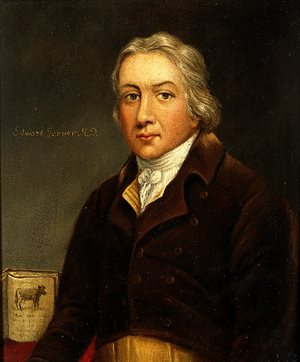 Edward Jenner was born and raised in Berkeley, a small town in Gloucestershire. It was there that he acquired a great interest in agriculture and the natural world.
Edward Jenner was born and raised in Berkeley, a small town in Gloucestershire. It was there that he acquired a great interest in agriculture and the natural world.
Aged 14, Jenner trained as an apprentice surgeon in the town of Chipping Sodbury, under the tutelage of Daniel Ludlow. Jenner came to London in 1770 to complete his medical training at St George’s, learning from the esteemed John Hunter, who quickly recognised Jenner’s talents as a surgeon and grasp of plant and animal anatomy. Hunter and Jenner were to become lifelong friends.
Jenner returned to Gloucestershire, where he worked as a general practitioner and surgeon for many years, covering an area of around 400 miles and often providing free medical care to those too poor to pay. It was during this time that he began work on his career-defining achievement.
Smallpox and milkmaids
Smallpox was a deadly disease that killed millions around the world each year, and if you were lucky enough to survive you were left with unsightly scars on your skin.
In 1774, Benjamin Jesty, a Dorset dairy farmer, made a breakthrough when testing his hypothesis that infection with cowpox, could protect a person from smallpox. In May 1796, Edward Jenner expanded on this discovery.
Jenner noticed that milkmaids seemed to be immune to smallpox, usually only contracting its less-deadly relative, cowpox. This gave Jenner an idea, and when in 1796 he diagnosed cowpox in a milkmaid called Sarah Nelmes – who had caught the disease while milking a cow by the name of Blossom – he saw an opportunity. He took samples of pus from Sarah’s pocks and injected them into James Phipps, the eight-year-old son of his gardener, who then developed cowpox.
Following this, Jenner inoculated James with smallpox and, when the boy recovered after initially falling ill, he knew his theory of vaccination was proved.
The success of this vaccination (from ‘vacca’, the Latin for ‘cow’) led to widespread use of the treatment, and smallpox was eventually eradicated in 1978.
Before vaccination, smallpox attacked one person in every three and killed one in 12. In the 20th century alone it killed 300 million people and left many survivors severely scarred or blinded.
The father of immunology
Aside from his discoveries around the smallpox vaccination, Jenner’s approach to his research and the zeal with which he marketed his findings was ground-breaking.
It could be said that his was work was the beginnings of controlled clinical trials to prevent disease. He met with considerable opposition among his peers and it took some time for his work to be officially recognised and implemented. Smallpox vaccination was only made compulsory in 1853, 30 years after Jenner died.
The hide of Blossom the cow, undoubtedly the most important bovine creature to have ever lived, was gifted to St George’s in 1857 to commemorate his achievement. The hide takes pride of place in the university library as a lasting monument to Jenner, the father of immunology.